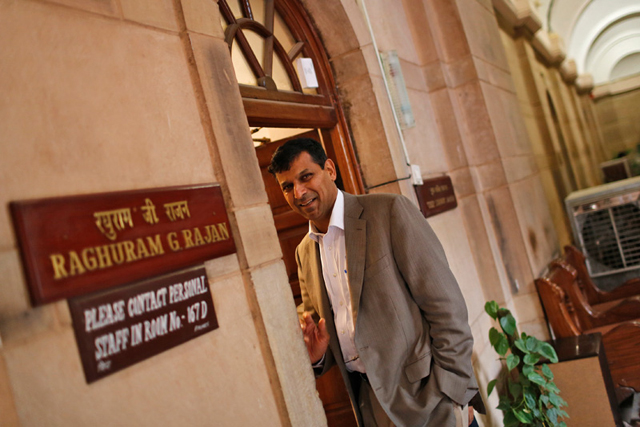The language of a central banker is always easy to understand and difficult to interpret. The nuances of it could confuse even the best minds, leave alone the common man.
But it isn’t too difficult to understand Raghuram Govinda Rajan.
In his third bi-monthly monetary policy press conference at Reserve Bank of India (RBI) on Tuesday, Rajan appeared more prepared; more at ease, to face the press.
“We won’t hold rates any longer than necessary,” he said in clear words. His words reflecting conviction and a reiteration of the promise made in the past.
Once again, Rajan repeated his promise -if retail inflation continues to sustainably ease on expected lines (8 percent by January, 2015 to begin with), there will be room to cut rates.
Read this with the guidance in the June policy announcement: “… if disinflation, adjusting for base effects, is faster than currently anticipated, it will provide headroom for an easing of the policy stance.”
Rajan has been consistent with his stance.
A closer look at the current inflation scenario could reveal the underlying meaning of his promise and the answer to the big question -when the first rate cut can happen?
Why Rajan did’t cut rate this time? The answer is simple. He does’t believe that the recent decline seen in retail inflation is sustainable going by the central bank’s yardsticks.
India’s retail inflation has stayed between 9 percent and 10 percent for consecutive nine months until December and above 8 percent in the subsequent months until May.
Only in June, the CPI fell below 8 percent - the central target for the RBI for January 2015-but that fall is attributable to higher base effect, rather than a genuine fall in the prices.
Wholesale price based inflation too fell in June to 5.43 percent. Trends in wholesale inflation are somewhat irrelevant at this point. But the WPI core inflation, or non-food, non-oil manufacturing inflation, has remained high in the recent months. That too made a case against a rate cut.
The RBI typically attaches a lot of importance to core inflation because of it is less volatile in nature, which makes it a better price indicator.
On the other hand, the core inflation has stayed above 3 percent for the last eight quarters. Although it eased a bit post March, the numbers have been sticky in the last three months.
Rajan indeed took note of the recent decline in the retail inflation numbers, but soon qualified that the decline may not necessarily reflect a genuine downward trend in prices and largely due to a base effect.
Rajan listed the risks that promoted him on Tuesday not to cut rates:
These include price pressures emerging from pass through of the administered price increases, uncertainty over monsoon and its impact on food inflation, possible spike in oil prices stemming from geo-political concerns and exchange rate movement and continuing supply concerns that impact growth.
Even though overall risks are more balanced than the June policy, “it is appropriate to continue maintaining a vigilant monetary policy stance as in June, while leaving the policy rate unchanged,” Rajan said.
Get this; the Indian central bank has adopted inflation-targeting as its central policy stance even though, form some reasons, Rajan is yet to openly admit that.
Will Rajan cut rates this year? As mentioned before, the answer is simple. If inflation eases sustainably over the next few months, interest rates are sure to come down. This could happen as early as in next policy review, else RBI will be on hold mode till it happens. The key word is how Rajan assesses the sustainability factor.
Take a closer look at the risk factors:
The monsoon scenario has indeed improved: Last week, the Meteorological Department issued a statement that backed by good rains received across the country in July, the monsoon deficiency has declined to 23 percent.
At the presser, Rajan said he believes below-par monsoon production doesn’t mean that below par production.
The government has enough stocks on rice and wheat but that isn’t the case with fruits and vegetables. Economists suggest that vegetable prices may continue on the higher side for some more time, unless the government steps in with tangible measures to address the supply constraints.
Rajan talks about the threat of pass-through of administered price increases. Here, a lot will depend on the movement of international oil prices and to what extend the government decides to pass on possible price increases to the end consumer.
Price hike in diesel prices is already underway. Last week, the government increased diesel price by 50 paise per litre and oil companies reduced petrol prices by one rupee.
The rupee has remained stable for major part of last one year, backed by a series of measures taken by the central bank to curtail volatility and improve inward capital flows. To be precise, in the last ten months, the local unit has traded in a range of 60-61 against the US dollar.
A stable government at the centre and improving investor confidence are likely to hold the rupee steady.
There are two rounds of inflation data due before the next policy announcement. Whether Rajan will cut rates in the remaining part of 2014 or India will hugely depend on the above factors, especially the nature of retail inflation in the coming months.


)
)
)
)
)
)
)
)
)



